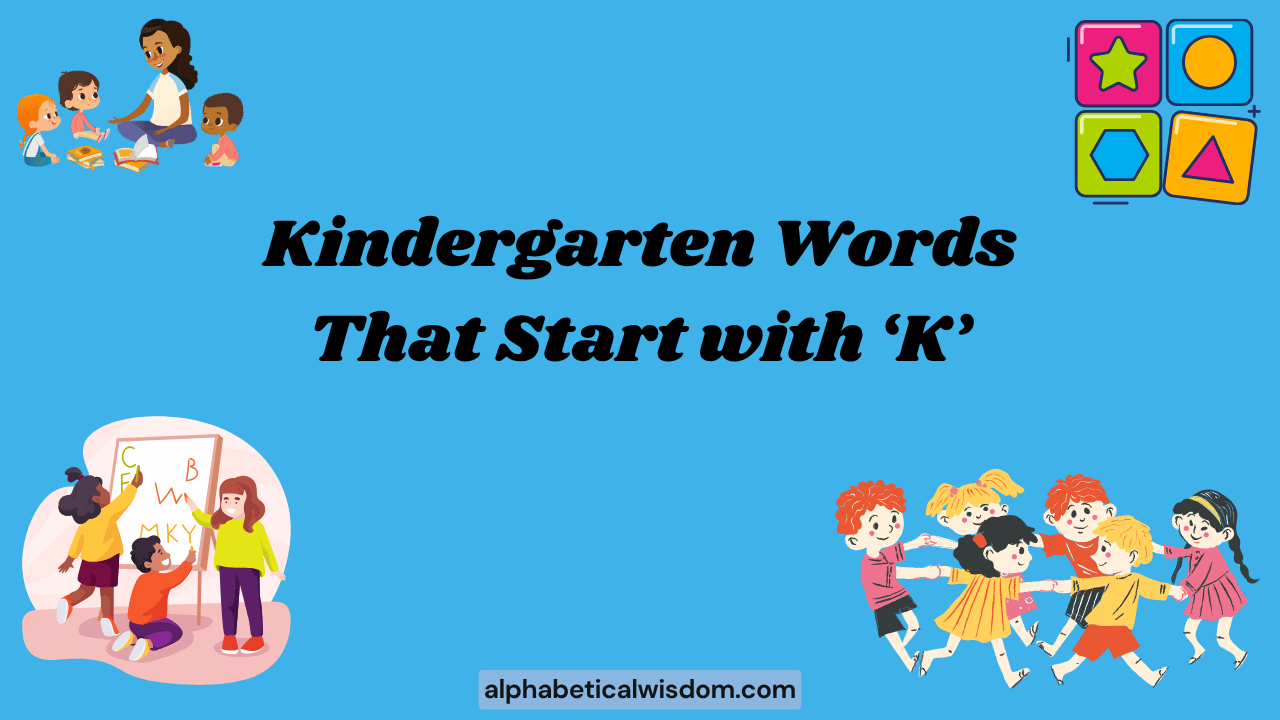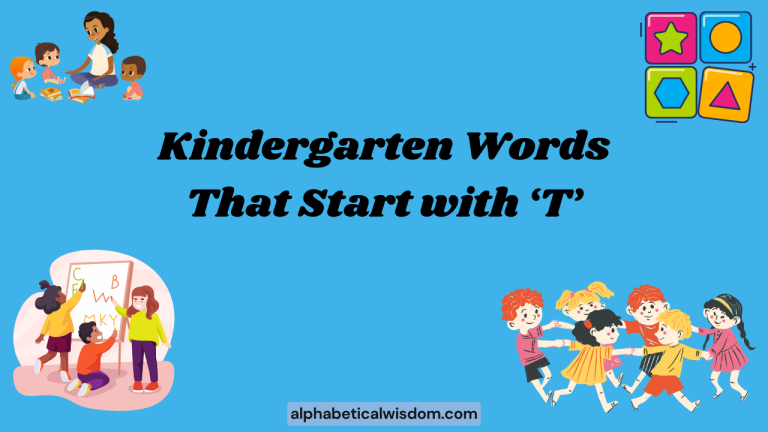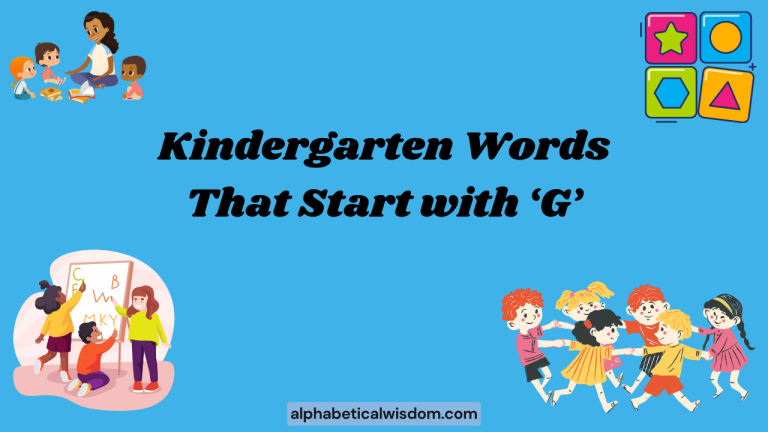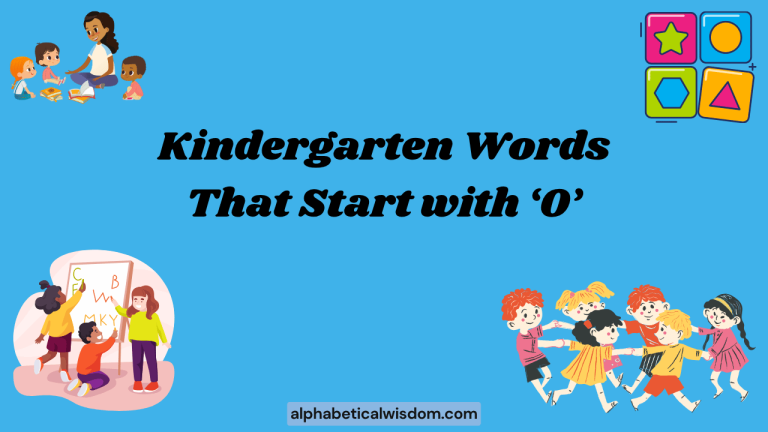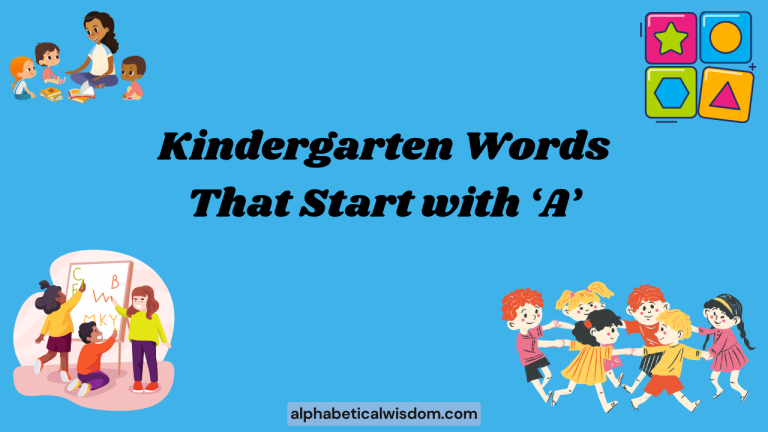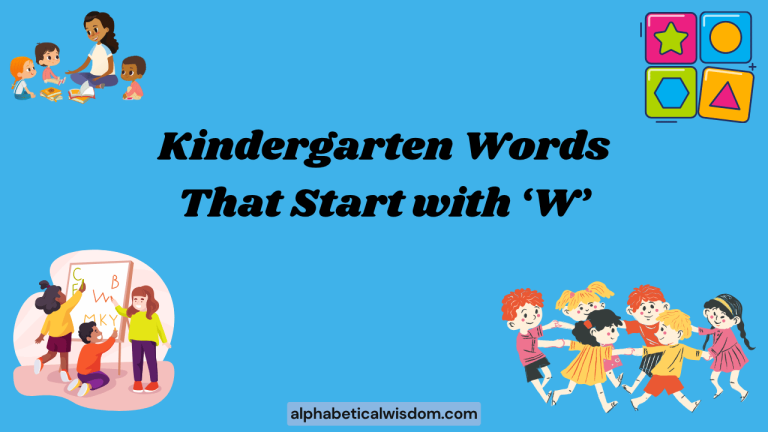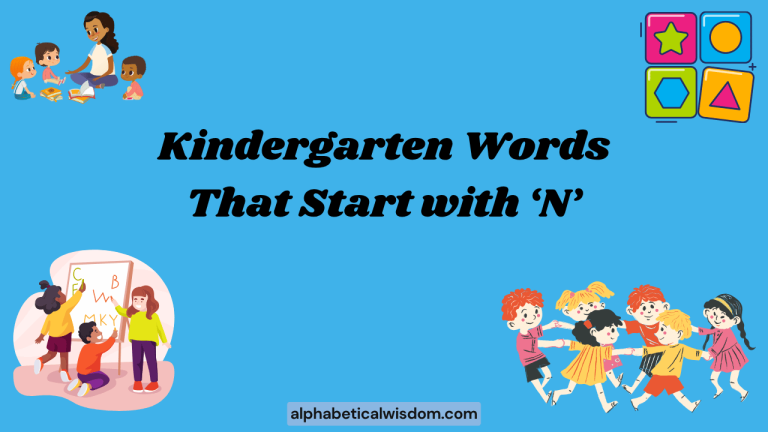Kindergarten Words That Start With K: A Comprehensive Guide
Understanding words is the foundation of language learning, and for kindergarteners, this journey begins by mastering simple words that kickstart their vocabulary. Focusing on words that start with the letter ‘K’ is a crucial step in this process.
These words not only enhance reading and writing skills but also improve cognitive development and communication abilities. This article provides a comprehensive guide to kindergarten words that start with ‘K,’ designed to help educators, parents, and young learners navigate this essential aspect of early literacy.
Table of Contents
- Introduction
- Definition of Kindergarten Words Starting With K
- Structural Breakdown of ‘K’ Words
- Types and Categories of ‘K’ Words
- Examples of Kindergarten ‘K’ Words
- Usage Rules for Kindergarten ‘K’ Words
- Common Mistakes When Using ‘K’ Words
- Practice Exercises
- Advanced Topics
- FAQ Section
- Conclusion
Definition of Kindergarten Words Starting With K
Kindergarten words starting with the letter ‘K’ are simple, age-appropriate terms that are typically introduced to children around the age of five or six. These words are designed to be easily recognizable and pronounceable, promoting early literacy and language development.
They generally consist of concrete nouns, action verbs, and basic adjectives that are relevant to a kindergartener’s everyday experiences.
The primary function of these words is to build a foundational vocabulary that enables children to understand and express themselves effectively. These words help children to describe objects, actions, and feelings, thereby fostering communication skills.
In a kindergarten setting, ‘K’ words are frequently used in reading lessons, writing activities, and interactive games, making learning fun and engaging.
Context plays a crucial role in understanding and using these words correctly. For example, the word “kite” is easily understood when accompanied by a picture or when used in a sentence like, “The kite is flying high in the sky.” By providing context, educators and parents can help children grasp the meaning and usage of these words, which in turn enhances their overall language comprehension.
Structural Breakdown of ‘K’ Words
Most kindergarten words starting with ‘K’ follow a simple phonetic structure that is easy for young children to decode. Typically, the letter ‘K’ is followed by a vowel or a consonant-vowel combination, creating a clear and distinct sound.
Understanding this structural pattern helps children to recognize and pronounce new ‘K’ words more easily.
The letter ‘K’ usually produces a hard /k/ sound, as in “kite” or “king.” However, there are instances where ‘K’ is silent, such as in the word “knife” or “know,” but these are generally introduced at a later stage of learning. For kindergarten words, the focus is primarily on words where ‘K’ is pronounced to reinforce the phonetic awareness of the letter.
Simple ‘K’ words often consist of three to five letters. This brevity makes them easier for children to remember and write.
For instance, words like “key,” “kid,” and “king” are short, structurally simple, and commonly used in kindergarten education. Teaching children to recognize these patterns can significantly improve their reading and spelling abilities.
Types and Categories of ‘K’ Words
Kindergarten words starting with ‘K’ can be categorized into several types based on their meaning and usage. These categories include nouns (naming words), verbs (action words), and adjectives (describing words).
Breaking down ‘K’ words into these categories helps children understand their different roles in a sentence and expands their overall language proficiency.
Nouns
Nouns are words that name people, places, things, or ideas. ‘K’ nouns commonly introduced in kindergarten include concrete objects and animals that children can easily relate to.
Verbs
Verbs are words that describe actions or states of being. ‘K’ verbs for kindergarteners are typically simple and describe common activities.
Adjectives
Adjectives are words that describe nouns, providing more information about their qualities or characteristics. ‘K’ adjectives help children enhance their descriptive language skills.
Examples of Kindergarten ‘K’ Words
Providing numerous examples is essential for reinforcing understanding. The following tables categorize ‘K’ words into nouns, verbs, and adjectives, offering a wide range of vocabulary for kindergarteners.
Animals
This table lists animals whose names start with the letter ‘K.’ Learning about animals is always engaging for young children.
| Word | Example Sentence |
|---|---|
| Kangaroo | The kangaroo hopped across the field. |
| Koala | The koala eats eucalyptus leaves. |
| Kingfisher | The kingfisher caught a fish in the river. |
| Krill | Whales eat tiny krill in the ocean. |
| Kitefin Shark | The kitefin shark lives in deep waters. |
| Klipspringer | The klipspringer is a small antelope. |
| Kakapo | The kakapo is a flightless parrot from New Zealand. |
| Kodiak Bear | The Kodiak bear is one of the largest bears in the world. |
| Kookaburra | The kookaburra’s laugh echoes through the Australian bush. |
| Komodo Dragon | The Komodo dragon is a large and venomous lizard. |
| Kagu | The Kagu is a flightless bird native to New Caledonia. |
| Kusimanse | The Kusimanse is a small mongoose found in West Africa. |
| Kestrel | The kestrel hovered in the air, searching for prey. |
| Killdeer | The killdeer is a type of plover that nests on the ground. |
| Knifefish | The knifefish has a long, slender body. |
| Katydid | The katydid sings its song at night. |
| Kentrosaurus | The Kentrosaurus was a dinosaur with plates and spikes. |
| Kiwi | The kiwi is a flightless bird from New Zealand. |
| Kob | The kob is a type of African antelope. |
| Kraken (Mythical) | The kraken is a legendary sea monster. |
| Kusa Grasshopper | The Kusa grasshopper is found in Madagascar. |
| Kangaroo Rat | The kangaroo rat hops on its hind legs. |
| Konik | Konik horses are a breed of semi-feral horses. |
| Kea | The kea is a parrot known for its intelligence. |
| Kissing Bug | The kissing bug feeds on blood. |
| Kitten | The kitten played with a ball of yarn. |
Objects
This table presents common objects that start with the letter ‘K’ and are familiar to kindergarteners.
| Word | Example Sentence |
|---|---|
| Key | I use a key to open the door. |
| Kite | The kite soared high in the sky. |
| King’s Crown | The king wore a golden crown on his head. |
| Keyboard | I type words on the keyboard. |
| Knapsack | I carry my books in a knapsack. |
| Kettle | The kettle whistled when the water boiled. |
| Kayak | We paddled the kayak down the river. |
| Kaleidoscope | The kaleidoscope showed beautiful patterns. |
| Karaoke Machine | We sang songs using the karaoke machine. |
| Knick-knack | The shelf was filled with knick-knacks. |
| Kiln | The pottery was fired in a kiln. |
| Kit | The doctor had a first aid kit. |
| Kerchief | She wore a kerchief to protect her hair. |
| Kickboard | I use a kickboard to practice swimming. |
| Kidney | The kidney helps filter blood in the body. |
| Kindling | We gathered kindling for the campfire. |
| Kiosk | We bought snacks from the kiosk. |
| Kitchen | Mom cooked dinner in the kitchen. |
| Knee Pad | She wore knee pads while skating. |
| Knot | He tied a knot in the rope. |
| Kraft Paper | We wrapped the gift in kraft paper. |
| Krumkake Iron | Grandma used a krumkake iron to bake cookies. |
| Kaftan | She wore a colorful kaftan at the beach. |
| Kente Cloth | The kente cloth was brightly patterned. |
| Keg | The keg was full of juice. |
Actions
This table includes verbs that start with the letter ‘K,’ describing common actions that kindergarteners can relate to.
| Word | Example Sentence |
|---|---|
| Kiss | She gave her mom a kiss. |
| Kick | I can kick the ball far. |
| Knit | Grandma likes to knit sweaters. |
| Keep | Please keep your toys tidy. |
| Know | I know my ABCs. |
| Knock | Knock on the door before entering. |
| Kneel | We kneel down to pray. |
| Kindle | We kindle a fire in the fireplace. |
| Kid | He likes to kid around with his friends. |
| Kowtow | They kowtow to show respect. |
| Knuckle | He hurt his knuckle playing basketball. |
| Keel | The boat keeled over in the storm. |
| Knap | He likes to knap flints for tools. |
| Kink | The hose had a kink in it. |
| Kip | Let’s kip down for a nap. |
| Kibitz | They kibitz while playing cards. |
| Kedge | They kedge the boat forward. |
| Kedge | They kedge the boat forward. |
| Kayo | The boxer kayoed his opponent. |
| Kayak | We kayak down the river every summer. |
| Knurl | He knurled the metal to add texture. |
| Knead | We knead the dough to make bread. |
| Keep Score | We keep score during the game. |
| Know Better | He should know better than to do that. |
| Knuckle Down | It’s time to knuckle down and study. |
Food
This table includes foods that start with the letter ‘K,’ introducing variety to their vocabulary.
| Word | Example Sentence |
|---|---|
| Kiwi | I like to eat kiwi for breakfast. |
| Kale | Kale is a healthy green vegetable. |
| Ketchup | I put ketchup on my fries. |
| Kidney Beans | Kidney beans are used in chili. |
| Kingfish | We grilled the kingfish for dinner. |
| Kumquat | The kumquat has a sweet and sour taste. |
| Kohlrabi | Kohlrabi can be eaten raw or cooked. |
| Kebab | We ate kebabs at the festival. |
| Knish | The knish was filled with potatoes. |
| Krispy Kreme | We got Krispy Kreme donuts for dessert. |
| Kabosu | Kabosu is a citrus fruit from Japan. |
| Kalamata Olive | Kalamata olives are dark and flavorful. |
| Kamut | Kamut is an ancient grain. |
| Kasha | Kasha is a type of buckwheat porridge. |
| Kedgeree | Kedgeree is a dish made with rice, fish, and eggs. |
| Key Lime Pie | Key lime pie is a tart dessert. |
| Kimchi | Kimchi is a spicy Korean side dish. |
| Kippers | Kippers are smoked herring. |
| Kirsch | Kirsch is a cherry brandy. |
| Kit Kat | I ate a Kit Kat bar for a snack. |
| Knafeh | Knafeh is a Middle Eastern cheese pastry. |
| Kringle | Kringle is a Scandinavian pastry. |
| Kulfi | Kulfi is an Indian ice cream. |
| Kuzu | Kuzu is a starch used in Japanese cooking. |
| Konbu | Konbu is a type of seaweed used in dashi. |
Descriptive Words
This table provides adjectives that start with the letter ‘K,’ helping children to describe things more vividly.
| Word | Example Sentence |
|---|---|
| Kind | She is a very kind girl. |
| Keen | He is keen to learn new things. |
| Kosher | This food is kosher. |
| Knowing | She gave a knowing smile. |
| Knobby | The tree had a knobby trunk. |
| Knotty | The wood was knotty and hard to cut. |
| Kaleidoscopic | The sunset was kaleidoscopic in color. |
| Keen-eyed | The keen-eyed detective solved the case. |
| Kindly | She spoke in a kindly manner. |
| King-sized | We bought a king-sized bed. |
| Kempt | He always keeps his hair kempt. |
| Key | That was a key detail in the story. |
| Killer | He made a killer presentation. |
| Kinetic | The sculpture had a kinetic design. |
| Kissable | She had kissable lips. |
| Knavish | The knavish character tried to trick us. |
| Knowing | He gave a knowing glance. |
| Kooky | She has a kooky sense of humor. |
| Karmic | There was a karmic justice in the end. |
| Kathartic | The experience was kathartic for him. |
| Kraken | The kraken waves crashed onto the shore. |
| Keen-witted | The keen-witted lawyer won the case. |
| Kenspeckle | The kenspeckle landmark was easy to find. |
| Kid-friendly | The park is very kid-friendly. |
| Kindly | She spoke in a kindly manner. |
Usage Rules for Kindergarten ‘K’ Words
Understanding the usage rules for ‘K’ words is crucial for correct application in sentences. This involves recognizing the part of speech (noun, verb, adjective) and using the word in a contextually appropriate manner.
For nouns, ensure they are used to name or identify objects, people, or places. Verbs should accurately describe an action, and adjectives should modify nouns effectively.
Pay attention to the subject-verb agreement when using ‘K’ verbs. For example, “I kick” is correct, while “I kicks” is incorrect.
Similarly, adjectives should be placed before the nouns they modify, such as “kind girl” instead of “girl kind.” Consistently reinforce these rules to prevent common errors.
There are few exceptions among common kindergarten ‘K’ words, but it’s important to note the silent ‘K’ in words like “knife” and “know,” which are generally introduced later on. For early learners, focus on words where the ‘K’ sound is pronounced to establish a strong phonetic foundation.
As children progress, introduce more complex words and exceptions gradually.
Common Mistakes When Using ‘K’ Words
One common mistake is confusing the sounds of ‘K’ with other letters, such as ‘C.’ For example, children might spell “kite” as “cite.” To correct this, emphasize the distinct /k/ sound of ‘K’ during pronunciation and provide visual aids that clearly differentiate the letters.
Another frequent error involves incorrect spelling due to phonetic misinterpretations. For instance, spelling “kick” as “kik.” Regular spelling practice and phonetic exercises can help children improve their spelling accuracy.
Encourage them to sound out the words and write them down, reinforcing the correct spelling through repetition.
Using ‘K’ words in the wrong context is also a common mistake. For example, using “key” when they mean “kite.” Provide context-rich examples and encourage children to use the words in sentences to ensure they understand their meanings.
Games and interactive activities can also help reinforce the correct usage of these words.
| Incorrect | Correct | Explanation |
|---|---|---|
| I cite the kite. | I see the kite. | Confusing the ‘K’ sound with ‘C.’ |
| The boy kik the ball. | The boy kicks the ball. | Misspelling due to phonetic confusion. |
| Use key to fly. | Use kite to fly. | Using the wrong word in context. |
| The koala is very kind. | The koala is cute. | Using an inappropriate adjective for the noun. |
| I knowed the answer. | I knew the answer. | Using the incorrect tense of the verb “know.” |
Practice Exercises
Practice exercises are crucial for reinforcing learning and ensuring that children can apply their knowledge of ‘K’ words effectively. These exercises are designed to be engaging and cater to different learning styles.
Exercise 1: Fill in the Blanks
Complete the sentences with the correct ‘K’ word from the word bank.
| Question | Answer |
|---|---|
| I use a ______ to open the door. (key, kite) | key |
| The ______ flies high in the sky. (key, kite) | kite |
| The ______ is a cuddly animal. (kangaroo, koala) | koala |
| The ______ hops very fast. (kangaroo, koala) | kangaroo |
| She is a very ______ girl. (kind, keen) | kind |
| He is ______ to learn new things. (kind, keen) | keen |
| I like to ______ the ball. (kiss, kick) | kick |
| She gave her mom a ______. (kiss, kick) | kiss |
| Please ______ your toys tidy. (keep, knit) | keep |
| Grandma likes to ______ sweaters. (keep, knit) | knit |
Exercise 2: Matching
Match the ‘K’ word with its correct definition.
| Word | Definition | Answer |
|---|---|---|
| Key | An animal that hops | C |
| Kite | A flying toy | D |
| Kangaroo | Opens a door | A |
| Kind | Being nice | B |
| Letter | Definition |
|---|---|
| A | Opens a door |
| B | Being nice |
| C | An animal that hops |
| D | A flying toy |
Exercise 3: Sentence Completion
Complete the following sentences using appropriate ‘K’ words.
| Question | Answer |
|---|---|
| I like to eat ______ for a snack. | Kiwi |
| The ______ has a long tail. | Kangaroo |
| She is very ______ to her friends. | Kind |
| I ______ the ball into the goal. | Kick |
| We use a ______ to unlock the door. | Key |
| The ______ is flying in the sky. | Kite |
| The ______ bear is big and brown. | Kodiak |
| The ______ is a bird from New Zealand. | Kiwi |
| I like to put ______ on my burger. | Ketchup |
| It is important to ______ your room clean. | Keep |
Advanced Topics
For advanced learners, exploring more complex ‘K’ words and their nuances can enhance their linguistic skills. This includes understanding words with silent ‘K’ (e.g., knife, knight, know), and how they evolved historically.
Additionally, exploring idiomatic expressions and compound words with ‘K’ can broaden their vocabulary and comprehension.
Delving into the etymology of ‘K’ words can also provide a deeper understanding of their origins and meanings. Many ‘K’ words have roots in various languages, including Germanic and Greek.
Understanding these linguistic connections can enrich their understanding of language evolution and cultural influences.
Furthermore, advanced learners can explore the use of ‘K’ words in literature and poetry. Analyzing how authors use ‘K’ words to create imagery, convey emotions, and develop themes can enhance their appreciation of language and literature.
This can also improve their creative writing skills by expanding their stylistic repertoire.
FAQ Section
This section addresses frequently asked questions about kindergarten words that start with ‘K,’ providing clear and concise answers to common queries.
- What are some easy ‘K’ words for kindergarteners?
Easy ‘K’ words include key, kite, kid, kind, and kick. These words are simple to pronounce and understand, making them ideal for early learners.
- How can I make learning ‘K’ words fun?
You can make learning fun by using flashcards, interactive games, and storytelling activities. Incorporating visuals and real-life examples can also enhance engagement.
- Why is it important to learn words starting with ‘K’?
Learning ‘K’ words builds a foundational vocabulary, improves reading and writing skills, and enhances cognitive development. It also helps children express themselves more effectively.
- Are there any silent ‘K’ words that kindergarteners should learn?
Generally, silent ‘K’ words are introduced later. Focus on words with a pronounced ‘K’ sound initially to avoid confusion. Silent ‘K’ words like “knife” and “know” can be introduced gradually as they progress.
- How can I help my child practice ‘K’ words at home?
You can help your child practice by reading books together, playing word games, and creating simple writing exercises. Make it a fun and interactive learning experience.
- What are some common mistakes to avoid when teaching ‘K’ words?
Avoid confusing ‘K’ with ‘C,’ ensure correct spelling through phonetic exercises, and provide context-rich examples to prevent misuse of words.
- How do I introduce the letter ‘K’ to a kindergartener?
Start by showing them the letter ‘K’ in both uppercase and lowercase forms. Associate the letter with familiar objects or animals that start with ‘K,’ such as “kite” or “kangaroo.” Use visual aids and interactive activities to make the introduction engaging.
- What if my child struggles to pronounce ‘K’ words?
Practice pronunciation by breaking down the words into smaller sounds. Use visual aids like mouth diagrams to show how the sound is produced. Be patient and provide positive reinforcement to encourage their efforts.
- How can I assess my child’s understanding of ‘K’ words?
Use simple quizzes, fill-in-the-blank exercises, and sentence completion activities. Observe their ability to use ‘K’ words correctly in conversation and writing.
- Can you suggest some books that feature ‘K’ words for kindergarteners?
Look for books that focus on alphabet learning and feature words starting with ‘K.’ Seek out books with colorful illustrations and simple sentences to engage young readers.
Conclusion
Mastering kindergarten words that start with the letter ‘K’ is a foundational step in a child’s language development. By understanding the definition, structure, usage rules, and common mistakes associated with these words, educators and parents can effectively guide young learners on their literacy journey.
Consistent practice, engaging activities, and a supportive learning environment are key to success.
Remember to reinforce learning through various methods, including visual aids, interactive games, and real-life examples. Patience and encouragement are essential as children navigate the complexities of language acquisition.
With a solid understanding of ‘K’ words, kindergarteners will be well-prepared for future literacy challenges and academic success.
